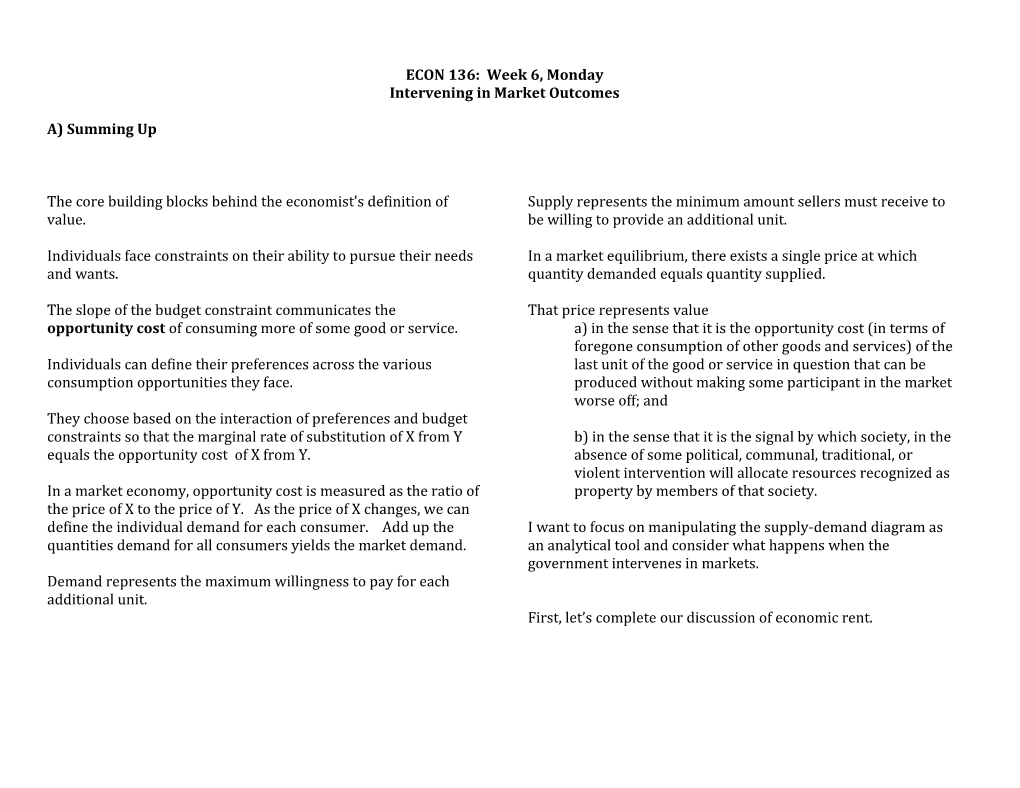ECON 136: Week 6, Monday
Intervening in Market Outcomes
A) Summing Up
1
The core building blocks behind the economist’s definition of value.
Individuals face constraints on their ability to pursue their needs and wants.
The slope of the budget constraint communicates the opportunity costof consuming more of some good or service.
Individuals can define their preferences across the various consumption opportunities they face.
They choose based on the interaction of preferences and budget constraints so that the marginal rate of substitution of X from Y equals the opportunity cost of X from Y.
In a market economy, opportunity cost is measured as the ratio of the price of X to the price of Y. As the price of X changes, we can define the individual demand for each consumer. Add up the quantities demand for all consumers yields the market demand.
Demand represents the maximum willingness to pay for each additional unit.
Supply represents the minimum amount sellers must receive to be willing to provide an additional unit.
In a market equilibrium, there exists a single price at which quantity demanded equals quantity supplied.
That price represents value
a) in the sense that it is the opportunity cost (in terms of foregone consumption of other goods and services) of the last unit of the good or service in question that can be produced without making some participant in the market worse off; and
b) in the sense that it is the signal by which society, in the absence of some political, communal, traditional, or violent intervention will allocate resources recognized as property by members of that society.
I want to focus on manipulating the supply-demand diagram as an analytical tool and consider what happens when the government intervenes in markets.
First, let’s complete our discussion of economic rent.
1
B) Finishing Up -- Supply, Profit and Rent
In the simplified models of introductory economics courses where identical consumers are buying goods and services from identical sellers, then free entry and exit ensure that economic profits are zero and price remains constant in the long run.
Market equilibrium generates consumers surplus but no producer surplus..
But, we know that long-run supply curves slope up! Why do they?
Quality differences
Increasing natural resource depletion costs
I claim that economic rent, not economic profit nor individual initiative, is the source of most of the observed inequality of wealth
C) Market Equilibrium and the Consequences of Government Intervention
1) A competitively supplied muffin market
a) Suppose the (inverse) demand for muffins is given by
P = 4 – 0.04Q
where Q is measured in thousands of muffins; and in the long run muffin producers cover all their costs of production (including salaries and dividends to investors) at a price of $2.00 per muffin. Add demand and supply curves to the graph and confirm that at a market equilibrium 50,000 muffins will be sold and purchased.
b) Confirm that the resulting consumer and producer surplus is $50,000 and 0 respectively.
c)
c) Suppose, however, that the production of muffins generates economic rent for more productive sellers so that the (inverse) supply curve is
P = 1 + .02Q
b) Confirm from the diagram and algebraically that the same market equilibrium (50,000 muffins at $2 per muffin emerges.
c) Confirm that the market now generates $25,000 in producer surplus.
d) Suppose the government now imposes a tax collected by sellers of $ 0.60 per muffin. Draw the new supply curve and confirm that at the new market equilibrium 40,000 muffins are sold, consumers pay $2.40 per muffin, but sellers keep only $1.80 per muffin.
e) Building on your analysis confirm that at the new equilibrium
CS = $32,000
PS = 16,000
Tax revenue = $24,000
And that the difference between the total of these three results and the sum of consumer and producers surplus in the absence of taxation is $3,000
2) A Severe Winter, Price Controls and the Market for Propane
Many families outside urban areas rely on propane for heat and cooking. The colder than expected winter resulted in a shift out in the demand for propane followed by a partial response by producers.
a) Label the attached diagram with
A – the initial equilibrium, 1.6 million bbl/day sold at $2.40 per barrel
B— equilibrium at the peak of the price spike ($4 per bbl)
C – equilibrium after the supply response.
b) Suppose the government had imposed a price ceiling at $3.60 per barrel. Find the excess demand and lost consumer and producer surplus resulting from the intervention.
1
